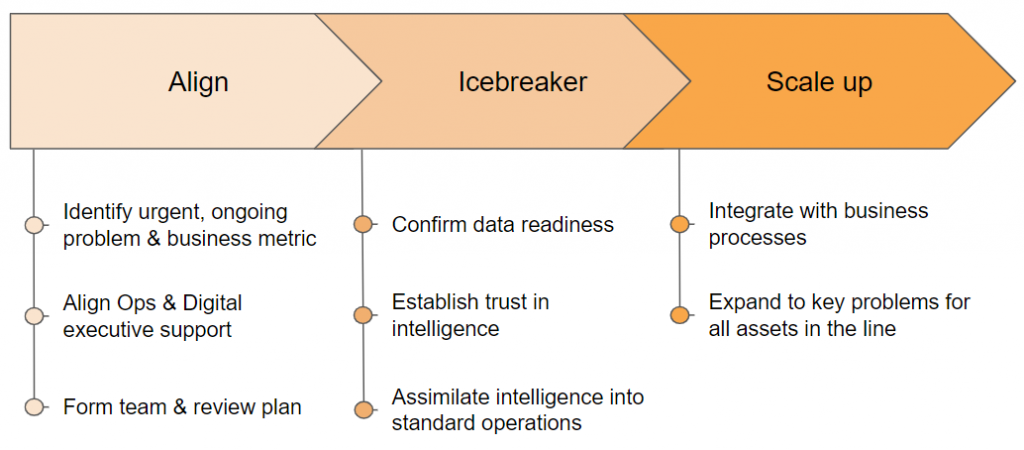The Intelligence-First Path to Smart Operations
Key takeaways:
- Intelligence is the act of finding actionable insights from current data.
- Intelligence-first starts a virtuous cycle of operational intelligence and improved operational performance.
- Intelligence-first enables a faster path to operational sustainability.
Accumulating data, on its own, does not create value: database-first approaches to achieving operational excellence in manufacturing don’t work. What operations require is understanding and solving current issues; providing actionable insights about such issues helps the operations team solve them. This is what we call an “intelligence-first” approach toward achieving smart operations.
After enabling smart operations for over 60 customers across a dozen industries, we have distilled this experience into three stages:
- Align – Ensure that there is a clear business need for smart operations, the organizational will to address that need and the resources to follow up on the intention.
- Icebreaker – When trying something new, it is difficult to know ahead of time what will be essential and what will not. Rapid learning by engaging directly in solving today’s problems is essential. Therefore, Skip the POC. “Just do it.”
- Scale up – Once the icebreaker has helped clarify the method, it is important to achieve scaled adoption that goes from the initial success in one area of the line to the broader success of putting an entire, fully functioning line into smart operation. Only at this level of scope can an organization truly begin to understand the benefits of AI-enabled operational excellence.

Sequencing the steps within the stages produces a high-level plan for an intelligence-first path to smart operations.
Align
- Identify urgent, ongoing problem & business metric
- Having urgent issues which drive people to act is important. It is also important that these be linked to a business metric or a strategic initiative which can be used to justify the priority of acting on the issue.
- Success: Identify at least one problem which stakeholders agree meets the urgency and importance criteria.
- Who: There are two approaches which can work either independently or in concert:
- Bottom-up: Production operations identify issues which affect the operational performance.
- Top-down: Manufacturing, Operational Excellence, and Digital leadership identify broader, strategic risks.
- Align Ops & Digital executive support
- The intelligence-first path to smart operations requires greater up-front alignment between the innovation and the operations teams. Both need to act even as the operations team needs to be driving right from the beginning of the journey.
- Success: Both front-line operations management and Digital management agree on the timing and need for action.
- Who: Executive sponsors from production operations (e.g. Plant management, VP Operational Excellence, VP Quality) and from Digitalization (e.g. CIO, CDO)
- Form team & review plan
- A working group which owns the smart operations project and is accountable for its success is required.
- Success: An operations expert (asset or process owner), project manager, IT support and escalation path are identified. Rough timeline, major milestones and a collaboration approach is agreed. A detailed, task-by-task project plan is not needed at this point.
- Who: Executive sponsor, program management, and operations experts.
Icebreaker
- Confirm data readiness
- The Intelligence-first path to smart operations requires that the right operational data sources (i.e. asset sensor data and, optionally, historical context data) be connected to intelligence systems.
- Success: Identify and confirm availability of required operational data sources. Create a plan for transmitting the required data and for updating data sources as learning dictates in step 5.
- Who: IT support (how to connect), operations expert (what to connect)
- Establish trust in intelligence
- Validating the insights which smart operations provide and determining how to best act upon them to achieve operational excellence in manufacturing are the first steps towards establishing trust in the intelligence process. These are the core tasks of “ice-breaking” and are carried out through the review of operational insights in daily operations meetings.
- Success: Operations experts identify actions they could take which address the urgent need(s) from step 1, even if no production interventions are made. Findings, potential actions and actual impacts are presented and discussed as part of daily operations meetings. Unexpected findings and new approaches to other problems enabled by the smart operations approach are discussed with the entire operations team.
- Who: Production operations team led by an operations expert.
- Assimilate intelligence into standard operations
- As operations experts incorporate intelligent actions into their daily decision making, they learn what is required to bridge AI and operations so that it leads to the desired outcomes. Their work leads to an understanding of the value that smart operations provide. It also highlights what is required to extract that value from the specific circumstances of the plant personnel, equipment and culture.
- Success: Production operations and Digital teams understand the impact that smart operations can have on the business and agree that the potential and/or realized impacts justify scaling up.
- Who: Operations and Digital executive sponsors and leadership, operations experts, IT lead.
Scale up
- Integrate with business processes
- Making smart operations a daily “habit” requires low friction integration with existing business processes for the company. Once the valuable aspects of a solution have been proven, it is much easier to integrate just those parts into the right places, minimizing costs and maximizing impact.
- Success: Identify reports, forms, visualizations, notifications and workflows required to enable the operational excellence gains to be sustained (e.g. better discovery process support or improved monitoring of target problem). Implement above integrations.
- Who: IT (systems knowledge), operations expert (what to change), operational excellence lead (process management)
- Expand to additional problems / assets / divisions
- Operational excellence in manufacturing is not achieved by solving a single problem. Once the approach has been de-risked by proving capability in one part of the line, it is important to expand to the remaining parts of the same line so that a complete benefits picture of smart operations can be formed.
- Success: Understand, prioritize and document the primary operational excellence challenges for the production line, including those elements which were not part of the ice-breaker. Establish a plan to test, review and deploy smart operations for each item, ideally in parallel, to maximize the rate of learning. Involve other teams as the plant’s organizational structure requires (e.g. process engineering, maintenance, different equipment owners, etc.). Align on a process the operational teams should use to identify and expand applications on their own to accommodate learning which comes during the process of scaling up to the entire production line, e.g. what level of executive approval is needed? How is IT support to be managed? Etc.
- Who: Production operations and IT executive sponsors (clear the way and establish this as a priority), operations teams (agree on what to do).
The path to sustainable operational excellence in manufacturing will shape the culture for the next generation of your workers. There will be new learning opportunities and new management challenges. However, we believe that taking an intelligence-first approach, one that emphasizes taking action on today’s problems using insights discovered from today’s data, will make for a more satisfying journey to smart operations.





